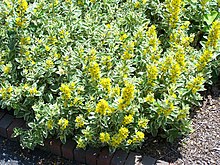| Lysimachia | |
|---|---|

| |
| Yellow pimpernel, Lysimachia nemorum | |
| Scientific classification | |
| Kingdom: | Plantae |
| Clade: | Tracheophytes |
| Clade: | Angiosperms |
| Clade: | Eudicots |
| Clade: | Asterids |
| Order: | Ericales |
| Family: | Primulaceae |
| Subfamily: | Myrsinoideae |
| Genus: | Lysimachia Tourn. ex L. (1753) |
| Species | |
|
282; see text | |
| Synonyms | |
Synonymy
| |
Lysimachia (/ˌlaɪsɪˈmeɪkiə/ LY-sim-AY-kee-ə) is a genus consisting of 182 accepted species of flowering plants traditionally classified in the family Primulaceae. Based on a molecular phylogenetic study it was transferred to the family Myrsinaceae, before this family was later merged into the Primulaceae.
Characteristics
Lysimachia species often have yellow flowers, and grow vigorously. They tend to grow in damp conditions. Several species within Lysimachia are commonly called loosestrife, although this name is also used for plants within the genus Lythrum. The genus is named in honor of Lysimachus, a king of ancient Sicily, who is said to have calmed a mad ox by feeding it a member of the genus.
Lysimachia species are used as food plants by the larvae of some butterflies and moths, including the dot moth, grey pug, lime-speck pug, small angle shades, and v-pug.
Specialized pollinators
Bees of the genus Macropis are specialized to pollinate oil-producing Lysimachia plants. These bees use exclusively Lysimachia floral oils for building their nests and provisioning cells. Lysimachia floral-specific chemicals are strong attractors for Macropis nuda and Macropis fulvipes bees that are seldom found in other plant genera.

Fossil record
Several fossil seeds of Lysimachia sp. have been described from middle Miocene strata of the Fasterholt area near Silkeborg in Central Jutland, Denmark. †Lysimachia nikitinii seed fossils have been collected from Pliocene strata of south eastern Belarus. The fossils are most similar to seeds of the East Asian Lysimachia davurica.
Selected species
Main article: List of Lysimachia species

282 species are accepted. Selected species include:
- Lysimachia arvensis L. – Scarlet pimpernel
- Lysimachia asperulifolia Poir., orth. var. L. asperulaefolia – roughleaf yellow loosestrife (endemic to Atlantic coastal plain in North and South Carolina)
- Lysimachia atropurpurea L. – purple gooseneck loosestrife
- Lysimachia azorica Hornem. ex Hook. – (endemic to the Azores)
- Lysimachia barystachys Bunge – Manchurian yellow loosestrife
- Lysimachia ciliata L. – fringed loosestrife (North America)
- Lysimachia clethroides Duby – gooseneck loosestrife
- Lysimachia × commixta Fernald – a hybrid of L. terrestris and L. thyrsiflora
- Lysimachia congestiflora Hemsl.
- Lysimachia daphnoides (A.Gray) Hillebr. – Lehua makanoe (Island of Kauaʻi in Hawaiʻi)
- Lysimachia filifolia C.N.Forbes (Islands of Oʻahu and Kauaʻi in Hawaiʻi)
- Lysimachia foenum-graecum Hance
- Lysimachia fraseri Duby – Fraser's yellow loosestrife (Southeastern United States)
- Lysimachia glutinosa Rock
- Lysimachia hillebrandii Hook.f. ex A.Gray – kolokolo kuahiwi (Hawaiʻi)
- Lysimachia hybrida Michx.
- Lysimachia iniki K.L.Marr – Wailua River yellow loosestrife (endemic to Kauai, Hawaii)
- Lysimachia japonica Thunb.
- Lysimachia latifolia (Hook.) Cholewa – Pacific starflower
- Lysimachia lichiangensis Forrest
- Lysimachia lydgatei Hillebr. – Maui yellow loosestrife (endemic to Maui, Hawaii)
- Lysimachia maritima (L.) Galasso, Banfi & Soldano
- Lysimachia mauritiana Lam.
- Lysimachia minoricensis J.J.Rodr. (Spain)
- Lysimachia nemorum L. – yellow pimpernel
- Lysimachia nummularia L. – creeping jenny, moneywort (Europe, introduced in North America)
- Lysimachia pendens K.L.Marr
- Lysimachia × producta (A.Gray) Fernald – a hybrid of L. terrestris and L. quadrifolia
- Lysimachia punctata L. – spotted loosestrife
- Lysimachia quadriflora Sims – four-flower yellow loosestrife (Eastern North America)
- Lysimachia quadrifolia L. – whorled loosestrife (Eastern North America)
- Lysimachia remyi Hillebr. (islands of Maui and Molokaʻi in Hawaiʻi)
- Lysimachia remyi subsp. maxima (Masam.) I.C.Oh & Anderb. (Molokaʻi)
- Lysimachia remyi subsp. remyi (Maui and Molokaʻi)
- Lysimachia scopulensis K.L.Marr
- Lysimachia sertulata Baudo – Chilean melilukul
- Lysimachia terrestris (L.) Britton, Sterns & Poggenb. – swamp candles (North America)
- Lysimachia thyrsiflora L. – tufted loosestrife
- Lysimachia venosa (Wawra) H.St.John – veined yellow loosestrife (endemic to Kauai, Hawaii)
- Lysimachia verticillaris Biehler
- Lysimachia vulgaris L. – garden loosestrife, yellow loosestrife (Eurasia)
References
- ^ Lysimachia Tourn. ex L. Plants of the World Online. Retrieved 20 May 2024.
- Sunset Western Garden Book, 1995:606–607
- M. Källersjö, G. Bergqvist & A. A. Anderberg (2000). "Generic realignment in primuloid families of the Ericales s. l.: a phylogenetic analysis based on DNA sequences from three chloroplast genes and morphology". American Journal of Botany. 87 (9). American Journal of Botany, Vol. 87, No. 9: 1325–1341. doi:10.2307/2656725. JSTOR 2656725. PMID 10991903.
- Angiosperm Phylogeny Group III (2009). "An update of the Angiosperm Phylogeny Group classification for the orders and families of flowering plants: APG III". Botanical Journal of the Linnean Society. 161 (2): 105–121. doi:10.1111/j.1095-8339.2009.00996.x. hdl:10654/18083.
- Lady Bird Johnson Wildflower Center, Native Plant Information Network (NPIN)
- Schäffler; Dötterl (February 2007). "Flower Scent of Floral Oil-Producing Lysimachia punctata as Attractant for the Oil-Bee Macropis fulvipes". Journal of Chemical Ecology. 33 (2): 441–5. Bibcode:2007JCEco..33..441D. doi:10.1007/s10886-006-9237-2. PMID 17151908. S2CID 23971483.
- Angiosperm Fruits and Seeds from the Middle Miocene of Jutland (Denmark) by Else Marie Friis, The Royal Danish Academy of Sciences and Letters 24:3, 1985
- The Pliocene flora of Kholmech, south-eastern Belarus and its correlation with other Pliocene floras of Europe by Felix Yu. VELICHKEVICH and Ewa ZASTAWNIAK - Acta Palaeobotanica 43(2): 137–259, 2003
External links
- Lysimachus' Dog & Nisaean Horses - Informative but non-scholarly essay on Lysimachia & Lysimachus (Annotated with Sources).
- Pictures of Lysimachia sertulata.
- PAF - Lysimachia clethroides - Duby.